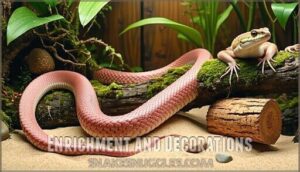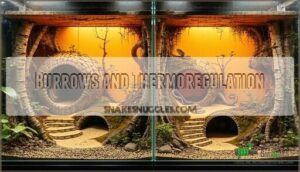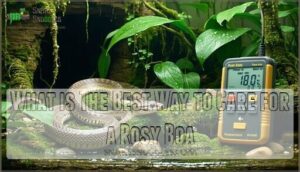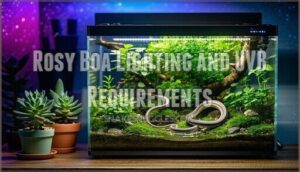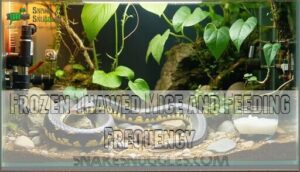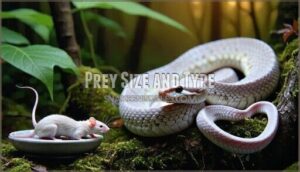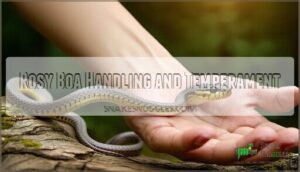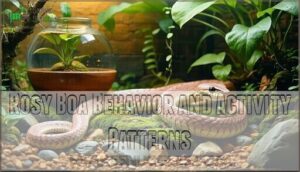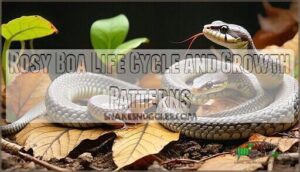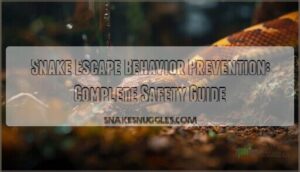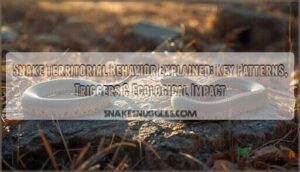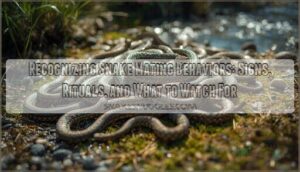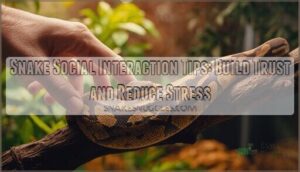This site is supported by our readers. We may earn a commission, at no cost to you, if you purchase through links.

You’ll need 12+ inches of substrate for burrowing, escape-proof front-opening terrariums, and temperature gradients from 75-88°F with nighttime drops to 60°F.
UVB lighting is essential for vitamin D3 synthesis, positioned 7-9 inches from mesh-covered bulbs.
Feed frozen-thawed mice every 5-7 days for juveniles, 10-14 days for adults, with prey no larger than 1.5 times your snake’s thickest section.
Handle gently, supporting the entire body, and watch for stress signs like appetite loss or defensive musk release.
The devil’s in the details when creating their perfect desert sanctuary with a focus on secure environments.
Table Of Contents
- Key Takeaways
- Rosy Boa Habitat Setup
- What is The Best Way to Care for a Rosy Boa
- Rosy Boa Lighting and UVB Requirements
- Temperature and Humidity for Rosy Boas
- Rosy Boa Feeding and Diet Essentials
- Rosy Boa Handling and Temperament
- Rosy Boa Substrate and Bioactive Options
- Rosy Boa Health and Hygiene Tips
- Rosy Boa Behavior and Activity Patterns
- Rosy Boa Life Cycle and Growth Patterns
- Frequently Asked Questions (FAQs)
- How often should I mist the enclosure?
- What size prey is safe to feed?
- Can rosy boas live together in one enclosure?
- How to identify the gender of a rosy boa?
- What signs indicate stress in rosy boas?
- What water requirements do rosy boas need?
- How often should rosy boas shed skin?
- Can rosy boas be housed together safely?
- What are signs of rosy boa pregnancy?
- Do rosy boas need special winter care?
- Conclusion
Key Takeaways
- You’ll need a 20-gallon long tank minimum with 12+ inches of substrate for burrowing, secure front-opening terrariums with locks, and temperature gradients from 75-88°F with nighttime drops to 60°F.
- UVB lighting is essential for vitamin D3 synthesis – position bulbs 7-9 inches from mesh covers and replace them every 12 months, even though they’re nocturnal animals.
- Feed frozen-thawed mice every 5-7 days for juveniles, 10-14 days for adults with prey no larger than 1.5 times your snake’s thickest body section to prevent regurgitation.
- Handle gently by supporting the entire body and watch for stress signs like appetite loss, defensive musk release, or excessive hiding – wait 48 hours after feeding before handling.
Rosy Boa Habitat Setup
Creating the right habitat setup determines your rosy boa’s long-term health and natural behaviors.
You’ll need to balance enclosure size, security features, and environmental enrichment to replicate their native desert conditions effectively.
Enclosure Size and Formula
Before buying your tank, consider your rosy boa’s adult size to prevent costly upgrades later.
Your reptile enclosure needs careful tank dimensions planning. A 20-gallon long terrarium works for most adults, but calculate using the 3x rule: enclosure length should equal three times your snake’s body length. This scaling factor guarantees proper thermoregulation and movement.
- Tank size: Minimum 20-gallon long for adults
- Space requirements: Length = 3x snake’s body length
- Enclosure depth: 12+ inches for substrate burrowing
- Vivarium setup: Width should be 1/3 of length
- Ventilation needs: Multiple air holes for proper airflow
Bioactive terrarium setups need extra space for plants and drainage layers, so consider upsizing accordingly.
Secure and Escape-Proof Enclosures
Your rosy boa’s enclosure security matters more than you think. These natural contortionists will exploit any weakness in your reptile enclosure design.
Front-opening terrariums with locking mechanisms provide superior escape prevention compared to screen-top tanks. Quality secure lids feature multiple latching points that distribute pressure evenly.
| Enclosure Type | Security Level | Best Locking Method |
|---|---|---|
| Front-opening terrarium | Excellent | Multi-point magnetic locks |
| Screen-top tank | Good | Heavy-duty clips + locks |
| Sliding glass doors | Fair | Track locks + door stops |
| DIY wooden vivarium | Variable | Cam locks + weather stripping |
| Plastic tub setup | Poor | Weighted lid + ventilation holes |
Check all ventilation gaps regularly—if your snake’s head fits through a opening, their entire body will follow within minutes.
Enrichment and Decorations
Once your enclosure is secure, creating an engaging environment becomes your next priority. Your rosy boa needs environmental variety to thrive, transforming their reptile terrarium into a dynamic ecosystem. Strategic decor options promote natural behaviors while supporting overall health.
Climbing structures at various heights encourage exploration and exercise. Install cork logs, cholla wood, and sturdy branches throughout the enclosure setup. Multiple hideouts at different temperatures allow proper thermoregulation choices.
Consider these essential reptile decor elements for optimal sensory stimulation:
- Live drought-resistant plants that create natural humidity pockets and visual barriers
- Textured surfaces like cork bark and ghost wood for tactile enrichment
- Varied substrate depths enabling natural burrowing behaviors in your bioactive terrarium
This reptile care sheet approach creates microenvironments mimicking their southwestern desert habitat, promoting psychological well-being and physical health through species-appropriate environmental complexity. Proper temperature gradients are vital for maintaining a healthy environment, and understanding boa constrictor enclosure is essential for creating a suitable setup.
Burrows and Thermoregulation
Your rosy boa habitat requires strategic burrow design to support natural thermoregulation behaviors.
Position multiple hideout placement options across your thermal gradients—warm side, cool side, and middle zones.
Use shelter options like cork bark, PVC pipes, or commercial hides filled with substrate that holds shape.
This temperature control system lets your snake choose ideal microclimates throughout the day.
Line burrows with topsoil-sand mix to satisfy digging instincts while maintaining structural integrity for repeated use.
What is The Best Way to Care for a Rosy Boa
Once you’ve established the perfect rosy boa habitat, maintaining your snake’s health becomes your daily priority. Think of boa constrictor care like tending a specialized garden – everything needs balance to flourish.
Your rosy boa care routine should follow these four pillars of success:
- Monitor daily behavior – Watch for normal hiding patterns, regular movement, and alert responses when you approach the enclosure.
- Maintain consistent rosy boa temperature zones between 75-90°F using reliable heating equipment and digital thermometers for precise readings.
- Track rosy boa diet schedules carefully – juveniles eat every 5-7 days, adults every 10-14 days with appropriately sized frozen-thawed prey.
- Practice proper rosy boa handling techniques by washing hands before contact, supporting the snake’s body, and keeping sessions brief to minimize stress.
Snake habitat design directly impacts your pet’s wellbeing. Reptile enrichment through cork bark, hiding spots, and climbing structures keeps your snake mentally stimulated. With consistent attention to these fundamentals, your rosy boa will thrive for over two decades.
Rosy Boa Lighting and UVB Requirements
While rosy boas are primarily nocturnal, they still require UVB lighting to maintain proper hormonal balance and synthesize vitamin D3.
Without adequate UVB exposure, your snake may develop metabolic bone disease and other health complications that can substantially impact their quality of life.
Nocturnal Nature and UVB Needs
Your rosy boa’s nocturnal behavior doesn’t eliminate their need for UVB lighting.
These desert dwellers require low-intensity UVB exposure to maintain healthy circadian rhythms and support vitamin D3 synthesis.
While they’re most active during cooler nighttime temperatures, daytime UVB helps regulate their photoperiod control and mimics filtered sunlight they’d encounter in their natural rosy boa habitat.
Choosing The Right UVB Bulb
Selecting proper UVB lighting transforms your rosy boa’s health from ordinary to extraordinary. The Arcadia ShadeDweller and Zoo Med T5 HO Reptisun 5.0 deliver ideal UVB intensity for nocturnal species.
These specialized reptile UVB bulbs provide 5-7% UVB output without overwhelming your snake’s sensitive nature.
- Your snake’s bones stay strong with consistent UVB exposure
- Proper bulb selection prevents metabolic bone disease nightmares
- Quality lighting cycles support natural hormonal rhythms
Replace UVB bulbs every 12 months regardless of visible light output. Choose T5 HO over T8 options for superior UVB penetration through enclosure materials.
Understanding UVB reptile bulbs is vital for maintaining a healthy environment.
Placement and Mesh Obstruction
Mesh Size matters more than you’d think when setting up your escapeproof enclosure.
Position basking heights 7-9 inches from mesh-covered UVB bulbs or 10-12 inches without screen placement.
Standard mesh blocks 40% of UVB rays, requiring closer positioning for adequate exposure.
| Setup Type | Distance (inches) |
|---|---|
| With Mesh | 7-9 |
| Without Mesh | 10-12 |
| Fine Mesh | 6-8 |
| Coarse Screen | 8-10 |
Obstruction removal improves UVB penetration in your reptile enclosure security system while maintaining proper ventilation systems.
Recommended UVB Bulbs and Lighting
Three reliable UVB options deliver ideal tank illumination for your rosy boa’s health:
- Arcadia ShadeDweller – Perfect low-intensity option with consistent UV Index output
- Arcadia T5 HO 6% – Excellent mid-range choice for standard enclosures
- Zoo Med T5 HO Reptisun 5.0 – Trusted brand with proven UVI performance
- Lighting cycles – Set timers for 12-14 hours daily to mimic natural patterns
Replace reptile lighting every 12 months for consistent bulb replacement effectiveness.
Temperature and Humidity for Rosy Boas
Creating the right thermal environment is essential for your rosy boa’s health and natural behavior patterns.
You’ll need to establish proper temperature gradients and humidity levels that mirror their native desert habitat while providing the thermoregulation opportunities they require for digestion, activity, and overall wellbeing.
Cold-Blooded Nature and Temperature Needs
Your cold-blooded rosy boa depends entirely on external heat sources for survival.
Thermoregulation governs their digestion, immunity, and activity levels.
You must provide precise temperature control through thermal gradients ranging from 75-88°F.
Without proper heating, your snake’s metabolism slows dramatically, compromising health.
Temperature monitoring guarantees proper thermoregulation, while humidity control prevents respiratory issues.
Heat Sources and Basking Areas
Your rosy boa needs proper heat lamps and basking spots for ideal health.
Install halogen flood bulbs above a spacious platform where your snake can fully coil. Multiple bulbs create even heating across the basking spot light area.
Position heat mats under one side to supplement warmth. Use an infrared thermometer for precise temperature control of surfaces. Heat tape usage works well under tanks.
This heating setup creates proper thermal gradients throughout the enclosure, supporting natural thermoregulation behaviors. Proper heat lamp systems are essential for maintaining the right environment.
Temperature Gradients and Nighttime Cooling
Since thermal cycling mirrors their desert origins, proper temperature gradients become essential for your rosy boa’s wellbeing.
Create heat gradients from 85-90°F basking spots down to 75-80°F cool zones. Nighttime drops to 60°F support healthy digestion and natural behaviors.
Temperature fluctuation through cooling methods like reducing heat tape usage maintains proper reptile temperature control.
Temperature control benefits:
- Mimics natural desert nighttime cooling patterns
- Supports healthy metabolic processes and digestion
- Reduces stress through familiar environmental cycles
Thermometers and Temperature Measurement
Accurate temperature monitoring requires two essential tools: an infrared thermometer for checking basking surfaces instantly, and a digital probe thermometer for continuous ambient readings.
Position probes on both warm and cool sides, monitoring daily fluctuations.
Your thermometer types determine successful temperature control – infrared units measure surface heat while digital probes track air temperatures throughout your temperature gradient setup.
Rosy Boa Feeding and Diet Essentials
Feeding your rosy boa correctly guarantees healthy growth and prevents common digestive issues that plague many captive snakes.
You’ll need to establish a consistent feeding schedule with appropriately sized frozen-thawed prey to mimic their natural hunting patterns and nutritional needs.
Frozen Thawed Mice and Feeding Frequency
Frozen thawed mice provide complete nutrition while eliminating risks associated with live prey.
Feeding frequency varies by age: juveniles require meals every 5-7 days, while adults thrive on a feeding schedule of every 10-14 days.
Proper thawing methods involve refrigerator defrosting overnight, then warming prey items in sealed bags under warm water to approximately 30°C.
Never microwave frozen thawed mice as uneven heating creates dangerous hot spots.
Use feeding tongs to offer prey safely and maintain natural strike responses.
Following established reptile feeding guidelines prevents obesity while supporting healthy digestion and growth patterns throughout your snake’s life.
Prey Size and Type
Selecting appropriate size prey items determines your rosy boa’s health and feeding success.
Choose frozen-thawed only prey measuring no wider than 1.5 times your snake’s thickest body section.
This prevents regurgitation and digestive stress.
Your rosy boa’s nutritional needs vary with size and age:
- Pinky mice work perfectly for juveniles and smaller adults
- Hopper mice satisfy larger specimens’ increased caloric requirements
- Small rats provide the best nutrition for coastal varieties reaching 44 inches
Prey variety mimics wild hunting patterns while frozen thawed mice remain the dietary foundation.
Proper prey size guarantees safe swallowing and complete digestion.
Juvenile and Adult Diets
Young rosy boas require feeding schedule consistency, eating frozen-thawed mice every 5-7 days for proper development.
Adults shift to 10-14 day intervals between prey items, often accepting small young rats.
This feeding schedule prevents obesity prevention issues while ensuring adequate nutrition.
Maintain proper hydration needs and avoid supplementation unless veterinary-recommended, as frozenthawed prey provides complete nutrition.
Wild Prey and Dietary Variety
Wild rosy boas demonstrate remarkable hunting strategies across diverse habitats, targeting prey that varies substantially by regional variations.
Understanding their natural diet helps you provide appropriate nutritional needs in captivity, though prey availability differs from wild conditions.
Prey items include:
- Small mammals like deer mice and kangaroo rats
- Desert lizards and juvenile snakes
- Occasional amphibians and bird nestlings
This snake feeding guide shows why feeder variety matters for your boa constrictor diet planning.
Rosy Boa Handling and Temperament
Rosy boas are naturally docile snakes that rarely bite or show aggression, making them excellent choices for both beginner and experienced keepers.
You’ll need to handle them gently and consistently to build trust, as proper socialization helps reduce stress and creates a more confident snake.
Docile Nature and Handling Tips
Rosy boas display remarkably docile temperaments, making them ideal for gentle handling sessions. Their calm nature reduces stress during interactions when proper techniques are applied.
| Handling Aspect | Best Practice |
|---|---|
| Safe Restraint | Support entire body, avoid head/neck grip |
| Reading Signals | Watch for tight coiling or defensive posturing |
| Building Trust | Use slow movements, consistent routine |
Positive reinforcement through regular, brief sessions helps establish confidence. Always approach from the side rather than above, mimicking natural predator avoidance patterns.
Handling tips include waiting 48 hours after feeding and maintaining clean hands to prevent bacterial transmission.
Socialization and Taming
Building trust with your rosy boa requires patience and consistent gentle handling. These naturally docile snakes respond well to positive reinforcement through regular, stress-free interactions. Individual differences mean some snakes warm up faster than others.
Effective taming techniques include:
- Short daily sessions of 5-10 minutes to build familiarity
- Gentle movements that respect your snake’s temperament and handling cues
- Consistent handling frequency to maintain trust without overwhelming
- Stress reduction by recognizing when your snake needs space
Common Handling Mistakes
Most handling errors stem from inexperience rather than malice. Understanding proper handling techniques prevents stress for both you and your rosy boa.
Common handling mistakes include these critical errors:
What to Do Instead
Overhandling frequency creates unnecessary stress. Limit sessions to 10-15 minutes every few days. Improper support means you’re not distributing the snake’s weight evenly across your hands. Squeezing too-tightly restricts breathing and circulation.
Scent recognition matters—wash hands before handling to remove food odors that trigger feeding responses. Ignoring signals like defensive posturing or rapid movement indicates your snake needs space.
Gentle handling builds trust over time, establishing positive associations that improve your snake’s temperament during future interactions.
Signs of Stress and Fear
Understanding when your rosy boa feels stressed helps prevent handling injuries and builds stronger trust.
Watch for defensive postures like tight coiling, erratic movements, or excessive hiding after handling sessions.
Stress manifests through these key signs:
- Appetite loss lasting multiple feeding cycles
- Releasing bad-smelling musk during or after handling
- Biting attempts or aggressive striking behavior
Scale changes or persistent hiding indicates your snake needs more recovery time between interactions.
Rosy Boa Substrate and Bioactive Options
Choosing the right substrate for your rosy boa creates a foundation that mimics their natural desert environment while supporting their burrowing instincts.
The substrate you select directly impacts your snake’s health, humidity levels, and overall comfort in their enclosure.
Natural Habitat and Substrate Choices
Successful substrate selection mirrors your rosy boa’s desert ecosystems found throughout southwestern regions.
These snakes inhabit diverse terrains from California’s rocky slopes to Arizona’s sandy washes, each presenting unique substrate texture and moisture retention challenges.
Regional variations influence your snake’s burrowing needs—coastal populations encounter different soil compositions than desert habitat dwellers.
Understanding these natural substrate choices helps you create appropriate captive conditions.
Consider how wild rosy boas navigate through various substrates when selecting your DIY mixes to ensure you are providing a suitable environment that mimics their natural desert ecosystems.
Recommended Substrate Options
Substrate selection impacts your rosy boa’s health and natural behaviors substantially.
Zoo Med ReptiSand and Exo Terra Desert Sand provide excellent burrowing opportunities while maintaining proper humidity levels.
Aspen Alternatives like coconut fiber offer dust-free options, though Sand Concerns include potential impaction if ingested.
Paper Substrates work well for quarantine situations.
See options for ReptiSand rosy boas for sale online.
Maintain sandy soil depth at 3-4 inches for ideal thermoregulation and comfort.
DIY Mixes and Bioactive Substrates
Building your own bioactive setup transforms your rosy boa’s enclosure into a living ecosystem.
Soil Composition matters: blend organic topsoil with sandy soil for proper Drainage Layers.
- Microfauna Benefits: Springtails and isopods break down waste naturally
- Plant Selection: Choose drought-tolerant succulents and snake plants
- DIY mix: 60% organic topsoil, 40% play sand ratio works best
- Long-Term Maintenance: Established substrates require minimal intervention
For enhanced humidity, consider sphagnum moss benefits in your substrate.
Maintenance and Cleaning
Enclosure cleaning becomes routine once you establish a schedule. Remove waste immediately and replace water every two days.
Substrate replacement occurs monthly for traditional setups, while bioactive systems need only spot-cleaning. Disinfection of décor happens quarterly using reptile-safe cleaners.
Monitor humidity control and temperature monitoring during maintenance to prevent environmental disruptions.
Rosy Boa Health and Hygiene Tips
Keeping your rosy boa healthy requires consistent monitoring and preventive care to catch issues before they become serious problems.
You’ll need to maintain proper hygiene practices and establish a relationship with a reptile-experienced veterinarian for the best long-term health outcomes.
Common Health Issues and Prevention
Vigilance serves as your best defense against rosy boa health complications. Respiratory issues manifest through mouth breathing and mucus bubbles, often stemming from inadequate temperatures or humidity levels. Skin problems like scale rot develop in overly moist conditions, while metabolic bone disease results from insufficient UVB exposure.
- Monitor for respiratory issues including wheezing, open-mouth breathing, and nasal discharge
- Check regularly for parasite control needs – mites appear as tiny moving specks on scales
- Prevent mouth rot through proper feeding techniques and enclosure sanitation
- Maintain proper humidity levels to avoid infection prevention and shedding complications
Cleaning and Disinfecting The Enclosure
Maintaining proper hygiene practices creates a healthy environment where your rosy boa can thrive without exposure to harmful bacteria or parasites.
Regular enclosure cleaning and disinfecting methods prevent waste buildup and maintain prime air quality for your snake’s respiratory health.
- Daily spot cleaning: Remove uneaten food, shed skin, and fresh waste immediately to prevent bacterial growth
- Weekly deep cleaning: Replace soiled substrate areas and sanitize water bowls with reptile-safe disinfectant solutions
- Monthly sanitation: Disinfect all décor, hides, and climbing structures using proper reptile enclosure cleaning protocols
- Bi-weekly glass cleaning: Wipe down enclosure walls with appropriate cleaning products to maintain visibility and hygiene
- Quarterly substrate replacement: Complete substrate changes guarantee long-term waste removal and prime sanitation tips implementation
Proper cleaning techniques involve understanding bioactive setup maintenance to guarantee a healthy environment for your rosy boa.
Veterinary Care and Consultation
Find a reptile veterinarian before you need one.
Veterinary checks catch snake diseases early, preventing costly medical emergencies. Schedule annual exams and maintain feeding, weight, and shedding records.
Research vets experienced with reptiles – not all exotic practitioners handle snakes. Keep emergency contact numbers accessible for after-hours crises.
Consider health insurance for expensive surgical care needs.
Quarantine and Isolation Procedures
Proper quarantine tanks protect your existing collection from potential health risks that new arrivals might carry.
Set up isolation methods using a separate enclosure at least 30 days before introducing any rosy boa to your main setup.
Effective biosecurity measures include:
- Keep quarantine supplies completely separate from main collection equipment
- Monitor eating patterns, elimination schedules, and behavioral changes daily
- Watch for respiratory symptoms, external parasites, or abnormal activity levels
- Document all observations for potential veterinary care consultations
Disease prevention starts with thorough health monitoring during this isolation period, ensuring parasite prevention protocols work effectively.
Rosy Boa Behavior and Activity Patterns
Understanding your rosy boa’s natural behavior patterns will help you create the ideal environment and care routine for your snake.
These fascinating reptiles display distinct activity cycles and behavioral traits that directly impact their feeding schedules, handling times, and overall wellbeing.
Nocturnal and Crepuscular Nature
Your rosy boa’s nocturnal nature means you’ll see peak activity during evening and early morning hours.
These snakes follow natural circadian rhythms, becoming alert as temperatures drop and darkness approaches.
Their crepuscular activity patterns align with hunting times in wild desert environments.
Dark adaptation gives rosy boas excellent nighttime activity capabilities.
They’ve developed specialized heat-sensing abilities and enhanced low-light vision for moving after sunset.
This nocturnal lifestyle helps them avoid daytime predators while staying cool in harsh desert climates.
Understanding these nocturnal habits helps you predict when your snake will be most responsive to handling and feeding schedules.
Hiding and Burrowing Behavior
Your snake will set up shop in hide boxes like a master architect designing their personal fortress.
These secretive creatures require multiple hiding spots across temperature zones to feel secure throughout the day.
Install at least three rock caves or commercial hides at different heat levels in your enclosure setup.
Your substrate should reach 4-6 inches deep to accommodate their natural tunnel systems – think of it as their underground subway network.
Watch them craft elaborate burrow design patterns, creating pathways that connect their favorite spots.
Proper soil depth allows this instinctive behavior while supporting natural thermoregulation.
Quality habitat decor and reptile hiding spots transform a basic tank into their dream home.
Understanding boa behavior patterns is essential for creating an environment that meets their physical and emotional needs.
Feeding and Hunting Behavior
Although your rosy boa appears motionless, it’s calculating every move during hunting strategies.
These carnivores use heat-sensing to detect prey items like rodents, then strike with 80% accuracy.
After constricting with 2-5 coils, they swallow whole animal prey head-first.
Their digestion patterns require 4-5 days, making proper feeding frequency essential for your reptile diet guide and feeding schedule.
Mating and Breeding Behavior
Breeding seasons typically occur during spring when temperatures rise and daylight hours increase.
Males track females using chemical signals and courtship rituals involve body positioning and gentle nudging.
Mating habits include multiple breeding attempts over several weeks.
Females produce three to five eggs after successful mating.
Egg incubation requires 120-150 days at ideal temperatures.
Breeding success depends on proper environmental conditions and hatchling development needs consistent humidity and secure enclosures.
Rosy Boa Life Cycle and Growth Patterns
Understanding your rosy boa’s growth stages helps you provide appropriate care throughout their 20-30 year lifespan.
You’ll witness dramatic changes from tiny 8-10 inch hatchlings to robust 2-3 foot adults, with each phase requiring specific attention to feeding schedules, enclosure sizes, and handling techniques.
Hatchling Care and Development
Starting with rosy boa hatchlings requires careful attention to their unique developmental needs.
Hatchling care demands precise environmental control and feeding schedules. Neonate care focuses on three essential elements:
- Housing setup – Use 10-gallon enclosures with secure hiding spots and appropriate substrate depth
- Hatchling feeding – Offer pinky mice every 5-7 days to support steady growth rates
- Temperature control – Maintain 75-80°F ambient with 85°F basking spot for ideal development stages
Monitor baby boas closely for proper growth patterns during these vital first months.
Juvenile Growth and Development
After the first shed, your juvenile rosy boa enters a critical development stage with distinct growth patterns.
Their feeding schedule shifts to weekly meals as growth rates accelerate substantially. The shedding process becomes more frequent, occurring every 4-6 weeks during rapid development phases.
Juvenile growth requires careful monitoring of these key factors:
- Feeding strategies – Weekly prey items sized appropriately for body width
- Prey size progression from pinkie mice to adult mice over 18-24 months
- Morph development – Color patterns intensify and become more defined
- Hatchling care transitions – Gradual enclosure upgrades as length increases from 8-12 inches to adult proportions
Adult Size and Weight
Adult rosy boas reach their full potential around 24-36 months old. Females typically grow larger at 24-34 inches and weigh up to one pound, while males stay smaller at 17-24 inches.
Female rosy boas typically outgrow males by several inches, reaching impressive lengths that showcase their robust desert heritage
Coastal varieties can reach 44 inches. Size Variations depend on genetics and locality, with Growth Rates slowing substantially after maturity. Adult Length averages 2-3 feet across most populations.
Average Size
Male Size
Female Size
Lifespan and Longevity
Your rosy boa can live 20-30 years with proper care—that’s a long-term commitment! These hardy reptiles outlive many pets when you provide consistent temperatures, regular feeding schedules, and clean environments.
Average Lifespan depends on several key longevity factors:
- Captive rosy boa lifespan: 20-30 years versus 10-15 years wild
- Age related health issues: Respiratory infections, parasites, obesity
- Mortality rates: Drop 40% with regular vet checkups
- Boa constrictor care: Temperature consistency prevents 5+ year lifespan reduction
- Lifespan expectations: Females typically outlive males by 2-3 years
Frequently Asked Questions (FAQs)
How often should I mist the enclosure?
Mist your rosy boa’s enclosure only when humidity drops below 40% or during shedding periods. You’ll rarely need to mist since these desert dwellers prefer dry conditions under 60% humidity.
What size prey is safe to feed?
A juvenile rosy boa stretches to swallow a pinkie mouse—prey width shouldn’t exceed the snake’s thickest body section.
You’ll feed appropriately-sized frozen-thawed rodents: pinkies for juveniles, adult mice for mature boas.
Can rosy boas live together in one enclosure?
No, you shouldn’t house rosy boas together.
They’re solitary creatures that can become stressed, aggressive, or compete for resources when cohabitated.
Separate enclosures prevent disease transmission and guarantee proper individual care.
How to identify the gender of a rosy boa?
Male rosy boas average 20% smaller than females at maturity.
You’ll identify males by their longer, thicker tail base containing hemipenes, while females have shorter tails tapering quickly after the vent opening.
What signs indicate stress in rosy boas?
Stressed rosy boas show decreased appetite, excessive hiding, irregular shedding, defensive posturing, and reduced activity.
You’ll notice them refusing food consistently, staying buried for days, or displaying aggressive coiling when handled.
What water requirements do rosy boas need?
Don’t let the water bowl become your snake’s Achilles’ heel.
Provide fresh, chlorine-free water in a shallow dish that’s cleaned weekly.
Your rosy boa needs constant access to hydration for proper shedding and health.
How often should rosy boas shed skin?
Healthy rosy boas shed every 4-8 weeks, with juveniles shedding more frequently than adults.
You’ll notice cloudy eyes and dulled colors before they shed—it’s completely normal behavior for growing snakes.
Can rosy boas be housed together safely?
No, you shouldn’t house rosy boas together. They’re solitary creatures that stress easily when cohabitated. Separate enclosures prevent competition for resources, territorial disputes, and potential cannibalism during feeding times.
What are signs of rosy boa pregnancy?
Like clockwork in the old west, you’ll notice weight gain around her midsection, increased appetite, and behavioral changes.
She’ll become less active, seek warmer spots more frequently, and may refuse food near delivery time, which can be a significant indicator of impending delivery.
Do rosy boas need special winter care?
Rosy boas don’t require special winter care since they’re naturally adapted to desert temperature fluctuations. You’ll simply maintain normal temperatures year-round, though they’ll naturally become less active during cooler months.
Conclusion
Master aquarists know that a thriving ecosystem requires precise parameters—your rosy boa’s terrarium operates on the same principle.
Every element in this rosy boa care sheet works together like clockwork: proper substrate depth enables natural burrowing, temperature gradients support thermoregulation, and UVB lighting promotes calcium absorption.
You’ve learned the fundamentals of creating a secure desert sanctuary that’ll keep your snake healthy for decades.
Remember, consistency in feeding schedules, temperature monitoring, and gentle handling builds trust with your serpentine companion, and success comes from attention to detail and patience.



